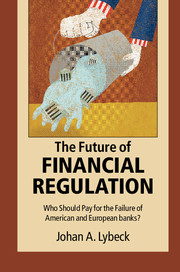Book contents
- Frontmatter
- Dedication
- Contents
- List of figures
- List of tables
- List of boxes
- Preface
- Acknowledgements
- List of abbreviations
- Introduction
- Part I A chronological presentation of crisis events January 2007 – December 2014
- Part II Bail-out and/or bail-in of banks in Europe: a country-by-country event study on those European countries which did not receive outside support
- Part III Bail-out and/or bail-in of banks in Europe: a country-by-country event study on those European countries which received IMF/EU support
- Part IV The TARP program and the bailing out (and bailing in) of US banks
- Part V Summary of the micro studies
- Part VI Political and regulatory responses to the crisis: to bail out or to bail in, that's the question
- Conclusion: toward host-country supervision and resolution?
- Addendum
- Bibliography
- Index
Part II - Bail-out and/or bail-in of banks in Europe: a country-by-country event study on those European countries which did not receive outside support
Published online by Cambridge University Press: 05 February 2016
- Frontmatter
- Dedication
- Contents
- List of figures
- List of tables
- List of boxes
- Preface
- Acknowledgements
- List of abbreviations
- Introduction
- Part I A chronological presentation of crisis events January 2007 – December 2014
- Part II Bail-out and/or bail-in of banks in Europe: a country-by-country event study on those European countries which did not receive outside support
- Part III Bail-out and/or bail-in of banks in Europe: a country-by-country event study on those European countries which received IMF/EU support
- Part IV The TARP program and the bailing out (and bailing in) of US banks
- Part V Summary of the micro studies
- Part VI Political and regulatory responses to the crisis: to bail out or to bail in, that's the question
- Conclusion: toward host-country supervision and resolution?
- Addendum
- Bibliography
- Index
Summary
In this and the next two parts of the book, a number of banks that were rescued, sold/merged or liquidated will be discussed. While there are most certainly a number of idiosyncratic factors at play in each individual case, five factors are common denominators in the crises, as shown in Figure 3 below. The five factors are:
• Aggressive and ill-timed mergers and acquisitions (M&A);
• Too low capital bases;
• Risky funding structures with too little stable retail customer deposits;
• Bad lending;
• Bad investments/trading.
The bank with which we will start in the next chapter, Northern Rock, had too low capital due to its rapid growth, a risky funding structure with over heavy reliance on wholesale deposits and a loan book of dubious quality, due to the housing boom. Lloyds Bank on the other hand collapsed mainly on account of its untimely purchase of Halifax Bank of Scotland (HBOS). Royal Bank of Scotland (RBS) is the only bank which succeeded in hitting all the five factors!
Obviously not all countries or all banks that faced the financial crisis of 2007 onwards are studied. I focus on Western Europe and the United States since this is where the crisis hit the hardest (see the Introduction). And in particular, I study the choice of bail-out with taxpayers’ money in contrast to bail-in with the money of creditors, depositors and other banks.
Some countries and banks such as Austrian Erste Bank and Hypo Group Alpe Adria, Swedish Carnegie Investment Bank and Latvian Parex Bank are mentioned in the Chronology (Part I) but omitted from the detailed study. Likewise, the injection of capital into French banks is not studied in detail since the banks involved were in no need of the rescue to the tune of 10.5 billion euro in fresh Tier 1 capital which was all the same (reluctantly) accepted by the EU Commission. In the United States, I leave out a discussion of the mortgage giants Fannie Mae and Freddie Mac, firstly because their bail-outs were a foregone conclusion given their status as “Government-Sponsored Enterprises” (GSEs) and secondly because their resolution and future destiny lie somewhat outside the theme of this book and are still unclear as it goes to press (September 2015).
- Type
- Chapter
- Information
- The Future of Financial RegulationWho Should Pay for the Failure of American and European Banks?, pp. 143 - 148Publisher: Cambridge University PressPrint publication year: 2016



